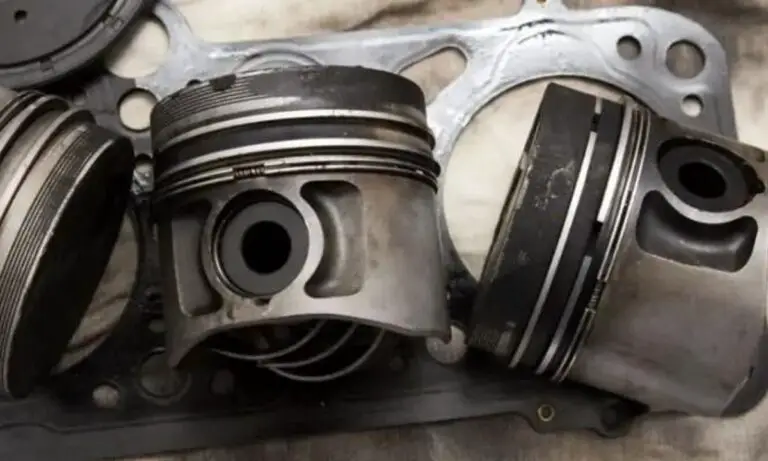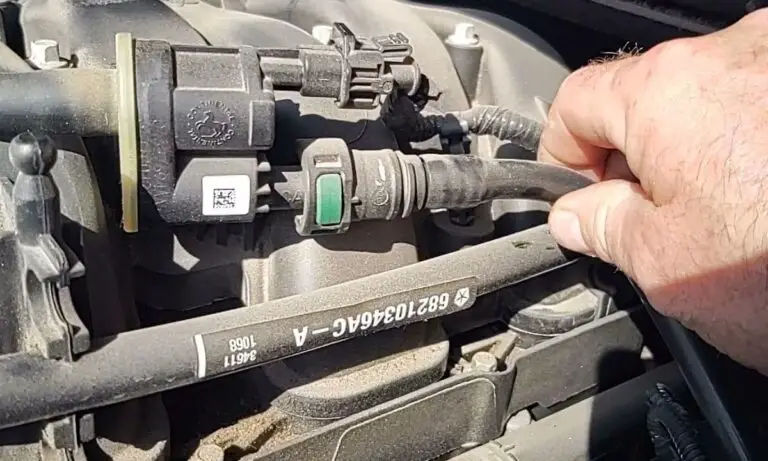Car AC Leaking Water? Causes and DIY Fixes

Finding a growing puddle of water underneath your car when you’ve been running the air conditioning is cause for concern. You might be wondering – where is this leak coming from? And how can I fix it? A leaking car air conditioner (AC) system can lead to some expensive repairs if left unchecked.
In this article, we’ll look at the common causes of a car AC leaking water, where the water could be coming from, signs to look out for, and how to fix the problem yourself or with a professional. Read on to diagnose and resolve AC leaks in your vehicle so you can keep cool on hot summer days.
Table of Contents
What Causes a Car’s AC System to Leak Water?
Your car’s air conditioning system needs to condense and remove moisture from the air to produce cool, dry air. This condensation builds up in the AC components and needs to drain out of the vehicle. Clogged drains or leaky parts prevent proper drainage and cause water to drip or pour out.
Here are the most common reasons an AC system leaks water in a car:
Clogged or Blocked AC Condensate Drain
The most common reason for AC water leaks is a clogged or blocked AC condensate drain. As the AC evaporator coils remove humidity from the cabin air, this condensation collects in the drain pan under the evaporator housing.
The water should flow through drain tubes or hoses out of the vehicle. But if the drain becomes clogged with debris, mold, leaves, or bacteria growth, the water can’t exit fast enough. This causes it to overflow the drain pan and leak into the vehicle cabin or onto the ground underneath the car.
A clogged condensate drain is often caused by infrequent AC system use, a cabin air filter that needs replacement, or organic matter accumulating in the drain hoses. Periodically cleaning the drain and hoses can remove clogs and prevent AC water leaks.
Leaking AC Evaporator
A damaged or leaking AC evaporator core can also cause water to leak from the air conditioning system. The evaporator is essentially a radiator through which refrigerant flows. Air passes over the cold evaporator coils and condenses moisture from the air, which collects in the drain pan.
If the evaporator coils spring a leak due to corrosion or damage, condensation inside the system can leak out. This often results in water dripping under the dash near the center console on the passenger side – directly under the evaporator housing.
Replacing a malfunctioning evaporator core or sealing leaks in the coil requires removing the vehicle dash to access the AC unit – an expensive and labor-intensive repair.
Leaky Heater Core
The heater core is part of the car’s cooling system and can also leak water into the cabin or under the car. Located under the dash right next to the AC evaporator housing, the heater core uses hot coolant from the engine to warm the air for the cabin heater.
If the heater core tubes or joints develop cracks and leaks, engine coolant can escape and drain into the interior or underneath the car. Since it’s located in the same housing, heater core leaks often get mistaken for evaporator leaks.
A damaged heater core must be replaced, which involves removing the entire dashboard – a complicated repair procedure that comes with a big labor cost.
Loose, Disconnected, or Cracked Drain Hose
The AC drain pan uses a plastic drain hose to channel the collected moisture out from under the car, away from the engine and electrical components. If this drain hose comes loose, cracks, or disconnects, the condensate water can leak out before reaching the intended exit point.
Cracked drain hoses most often occur from plastic tubing that becomes brittle with age. Loose connections can happen when the hoses slide off the nipples. And disconnects are typically caused by stress and kinks in the hose.
Replacing drain hoses and securely reconnecting them is an easy and inexpensive fix to prevent many AC water leaks. Just be sure to use the specified diameter hose for your vehicle make and model.
Where Does the AC Water Leak Inside the Car?
If your vehicle’s air conditioner is leaking, the water may be noticeable in certain locations in and around the car:

Inside the Cabin
If you notice water pooling on the floor of the front or back seats after running the air conditioning, the condensate drain is likely clogged. With nowhere to go, the water overflows the drain pan and drips out into the vehicle cabin.
Excess AC condensation dripping into the interior can damage carpets, padding, and electrical systems. Have the drain immediately cleared of obstructions to prevent mold and mildew from forming under the wet carpets.
Under the Car
Seeing a puddle of water on the ground under the front passenger side of the car often points to a clogged AC drain. The overflow that can’t exit through blocked drain hoses will run down external drain tubes under the vehicle.
Leaks originating under the dash near the center console indicate an evaporator leak. While leaks farther back near the center of the car hint at a leaky heater core.
Front of Vehicle
Water leaking from under the front corners or underside of the vehicle may come from a damaged or disconnected condensate drain hose. These hoses need to carry moisture away from under the vehicle to an exit point, often in front of the engine compartment.
Cracked or disconnected drain hoses should be replaced right away to prevent an interior water leak and further corrosion damage to undercarriage components from dripping AC condensation.
Signs Your Car’s AC System is Leaking Water
Watch for these common indicators of a Freon and water leak in your car’s air conditioning system:
- Puddles or dripping water under the car when running the AC. Look under the front passenger area.
- Wet carpeting or damp floor mats inside the car cabin after AC use.
- A mildew, moldy or musty odor coming from inside the vents.
- Interior windows fogging up easily since the AC removes humidity.
- Poor cooling performance from the AC despite settings being maxed out.
- Low refrigerant levels caused by leaks lowering AC efficiency.
Don’t ignore these signs of water leaks – have your air conditioning system inspected by a mechanic and repaired to prevent expensive damage. Catching AC problems quickly can reduce repair costs.
How to Find the Source of the Leak?

Finding where exactly the water is coming from is the critical first step before attempting repairs. Here are tips on diagnosing the source:
- Check under the car – Look for water dripping or puddles forming under the front passenger side when the AC is used. This pinpoints the general region to inspect.
- Check carpets and mats – Feel for dampness in the front and back footwells after AC use. Interior leaks mean a clogged drain or evaporator issue.
- Monitor air from vents – Smelly or overly humid air indicates a drain blockage. Lower airflow points to low refrigerant.
- Consider smells – A musty odor suggests mold from standing water, often due to a clogged drain tube.
- Assess cooling ability – Poor cooling after AC recharge hints at a significant refrigerant leak.
- Consider noises – Bubbling or gurgling noises from under the dash can signal a clogged drain pipe.
- Review service records – Look for past AC repairs or recharges. Recurring issues indicate a larger problem.
Pinpointing the leak source is key for choosing the right repair method.
How to Fix a Leaking Car Air Conditioner
Once you’ve determined the general location and cause of the AC leak, here are the steps for DIY repairs or professional service:
1. Thoroughly Clean the AC Drain
Use a thin wire or compressed air to loosen debris and clear obstructions from the AC drain hoses and drain tube outlet. Then flush the drain pan and all hoses using a disinfecting coil cleaner to discourage further organic growth.
This may require removing an access panel under the glovebox. Check drain hoses under the vehicle as well. Proper drainage should be restored.
2. Replace Any Damaged Drain Hoses
Inspect all rubber drain hoses for cracks, kinks, or blockages. Repair any compromised sections or replace hoses that cannot be cleared. Ensure connections are secure.
Use hose material and diameter rated for AC use on your specific vehicle. Never sub in standard radiator hose.
3. Unclog Blocked AC Condenser Fins
Use a fin comb tool to straighten any bent condenser fins and clear debris from the condenser surface. Proper air flow over the condenser improves the cooling capacity.
Also check that the condenser is not blocked by bugs, leaves, or other objects.
4. Recharge the AC System with Refrigerant
Leaks often result in low system pressure from lost refrigerant. Have an HVAC technician recharge your AC unit with fresh R-134a refrigerant to the factory recommended level. This should restore cooling performance.
Recharging may reveal the leak point if pressure keeps dropping. A dye may be injected then traced under UV light.
5. Replace Leaky Evaporator or Heater Cores
For water leaks due to a damaged evaporator or heater core, the leaking component will need replacement by a certified auto technician. This requires dash removal and new OEM parts installed.
Labor costs are high for this major repair. Prices range from $1200-$2000+ for evaporator replacement, and $800-$1500+ for heater core service.
Preventing Future AC Water Leaks
Take these proactive maintenance steps to minimize the chances of water leaks in your vehicle’s air conditioning:
- Have annual AC system inspections before cooling season starts. A technician can find issues early.
- Change the AC cabin air filter regularly per the maintenance schedule. Clogged filters can block drains.
- Keep the AC condenser surface clean and fins clear of debris for proper air flow.
- Run the AC monthly for 10 minutes, even in cold months. This circulates lubricants to prevent compressor seizures.
- Address strange AC smells immediately to prevent mold growth in the vents and drain pan.
- Inspect plastic drain hoses each season. Look for kinks, cracks, blockages. Replace if damaged.
- Consider an evaporator treatment to prevent corrosion leaks.
Proper preventive maintenance keeps all AC components in top shape. This ensures condensate can exit the system efficiently and not leak into the cabin or under the car.
Fixing a Leaking Car AC: Conclusion
Water leaking from your car’s air conditioning system is most often due to clogged or disconnected condensate drains. But refrigerant leaks and evaporator issues can also cause unwanted moisture.
Start by pinpointing the source of the leak based on where you see water pooling. Try DIY steps like cleaning the AC drain before refrigerant recharges or repairs for a damaged evaporator or heater core.
Catching AC problems quickly can minimize expense. But left unchecked, moisture damage can lead to major system repairs. With some TLC and fast diagnosis of any leaks, your vehicle’s air conditioning will keep you cool and comfortable all season long without any wet surprises.







